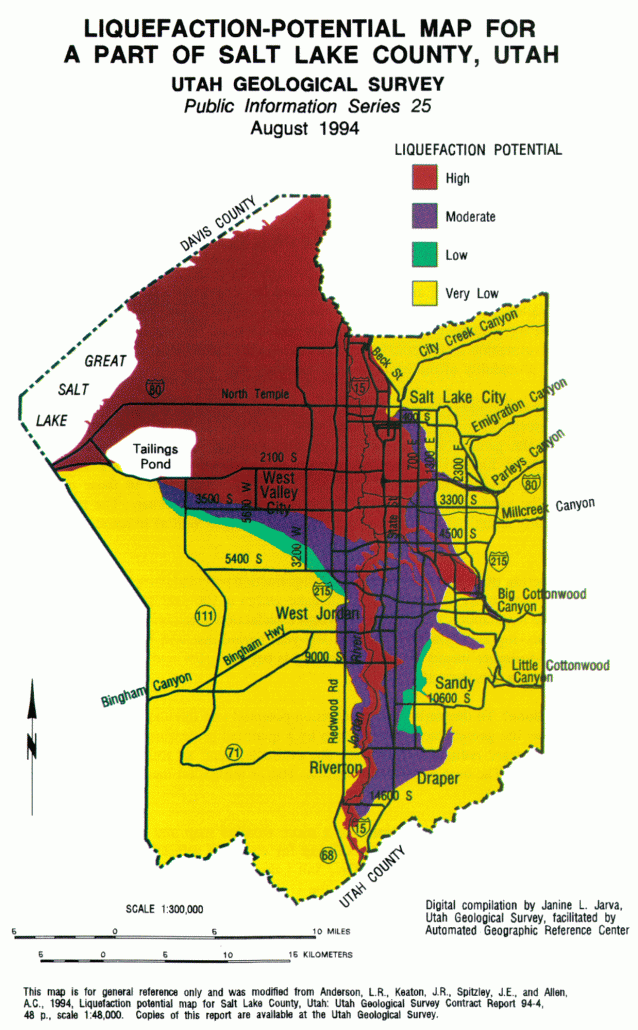The damage a building receives during an earthquake depends on a number of factors below that are in ALL CAPS:
BUILDING CONSTRUCTION -- Wood-framed homes generally fare better than masonry, especially if masonry isn't reinforced. Most modern buildings, built after 1975, should be survivable, which means that they will stand up long enough for people to survive and evacuate.
Buildings that survive major shaking may not be usable afterward, though. Aftershocks can bring down buildings that survive an initial shock. The @UtahSeismic Safety Commission has a guide for retrofitting unreinforced masonry homes at http://ussc.utah.gov .
In older homes, the roof may not be connected to the walls, or the walls may not be tied to the foundation.
EARTHQUAKE DEPTH -- Earthquakes can occur near the surface of the earth or quite deep. A strong earthquake that happens deep in the earth may not have the same impact as a weaker earthquake that happens near the surface. Deep earthquakes are felt over wider areas.
DISTANCE -- The farther away you are from the epicenter, the more likely you are to be better off during an earthquake. This is a rule of thumb. Energy dissipates throughout the earth, and less energy/shaking will reach you if you are far away.
GEOLOGY -- The type of ground you are built on also has an impact. If your building is on bedrock, it will do better generally than a building in a liquefaction zone, such as much of the Salt Lake Valley. Liquefaction can do some crazy things, like causing buildings to tilt.
Here is a liquefaction potential map for Salt Lake County. It was produced by our friends at @utahgeological. Read more here: https://geology.utah.gov/hazards/earthquakes-faults/liquefaction/ …
Much of the Wasatch Front is built in a liquefaction zone. This is because most of our valleys in northern Utah were once part of ancient Lake Bonneville. Ancient lake bed do not always do so well under intense shaking.
GROUND ACCELERATION -- This refers to how quickly the ground moves underneath your building. Is your building receiving the initial shock? Or is it riding some waves?
A small percent of buildings out of our entire building stock will collapse. Unfortunately, a small percent is still thousands of buildings. If you are in a newer or retrofitted building, far from the epicenter, your risk is lower.
JOIN in the world’s largest earthquake drill: The Great Utah ShakeOut on Thursday, April 18 at 10:15 a.m. The best safety action you can take during an earthquake is DROP, COVER and HOLD ON until the shaking stops. People are more likely to be injured or killed by nonstructural things falling on them than by a building collapse. https://www.earthquakecountry.org/dropcoverholdon/ …
You can secure items such as artwork, shelves, trophies or pottery as part of your participation in this year's Great @UtahShakeOut. We call it "securing your space." Or use this time to make an improvement to your 96-Hour Emergency Kit.
There will still be many buildings that do collapse. This scientific document considers many factors in earthquake modeling and gives us an idea of what a magnitude 7.0 earthquake would do in Salt Lake. https://ussc.utah.gov/pages/help.php?section=EERI+Salt+Lake+City+M7+Earthquake+Scenario …
A couple of striking things from that scenario are the following: • 2,300 fatalities • 84,000 displaced households • 480,000 homes without potable (drinking) water. We have a video version of this scenario here. Copy this link. https://www.youtube.com/watch?v=OXIM4Nf3gZ
We are constantly sharing preparedness ideas from our @BeReadyUtah team. Preparedness = Confidence. Just start by making sure you have shoes and a flashlight next to your bed. You can find more tips from us at any time.
Want to learn more about faults in Utah? Start here: https://geology.utah.gov/hazards/earthquakes-faults/utah-faults/ … Here's our list of #earthquake and geology gurus: https://twitter.com/UtahEmergency/lists/geology-earthquake-gurus/members …
Those are the basic factors. A seismic engineer like @bhwelliver, or scientists from @UUSS_Quake_Info or @utahgeological or @AdamIsaac88 @emkleb and @chrisduross might have more to add to this thread. Tagging @SeismoSocietyAm @EERI_tweets and the eminent @DrLucyJones for fun.
As of 2/23/19, at our last count, we felt 8 earthquakes this month #earthquake .
Pick one preparedness thing you can do every week, starting now -- and do it. Here's a sample list from a poll we did this week. https://twitter.com/UtahEmergency/status/1098256702929924096 …



No comments:
Post a Comment
Your comments are welcome: